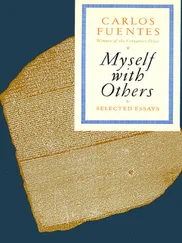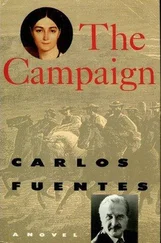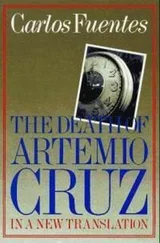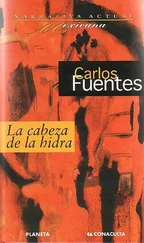How different Xalapa was. At night, Veracruz retained — and increased — the heat of the day. Xalapa, in the mountains, had warm days and cold nights. Veracruz had swift, rackety storms, but here the rain became fine, persistent, making everything green and filling a central point in the city — the reservoir behind the El Dique dam, always about to overflow, giving an impression of sadness and security at the same time. It was from the flume that the city’s light mist rose to meet the mountain’s thick fog; Laura Díaz is remembering when she first came to Xalapa and noted: cold air — rain and rain — birds — women dressed in black — beautiful gardens — cast-iron benches — white statues painted green by the humidity — red tiles — steep narrow streets — market smells and bakeries, wet patios and fruit trees, the aroma of orange trees and the stench of slaughterhouses.
She entered her new home. Everything smelled of varnish. It was a one-story house, for which the family would very soon be thankful. Laura immediately told herself that in this city of intermittent fogs she would let herself be guided by her sense of smell, that that would be the measure of her tranquillity or her disquiet: humidity of parks, abundance of flowers, the many shops, the smell of tanned hides and thick tar, of saddleries and hardware shops, of cotton bales and hemp rope, the smell of shoe shops and pharmacies, of hairdressers and calico. Perfumes of boiled coffee and foamy chocolate. She pretended to be blind. She touched the walls and felt their heat, she opened her eyes and the tile roofs washed by the rain were shining, dangerously pitched, as if they longed for the sun to dry them and the rain to run down the gutters, along the streets, through the gardens, from the sky to the flume, all in motion, in this reticent city, mistress of incessant nature.
The house replicated the Hispanic model prevalent all over Latin America. Blind, impenetrable walls faced the street, with an unadorned entry, pitched roof, and tiling in place of cornices — a typical “patio house,” with public rooms and bedrooms distributed around an open quadrangle filled with large flowerpots and geraniums. Doña Leticia brought along everything she considered hers, the wicker furniture designed for the tropics that gave no protection here from the moisture, the two paintings of the rascal and the snapping dog, which she hung in the dining room.
The kitchen satisfied Leticia; it was her private domain, and in a short time the lady of the house adapted her coastal customs to the tastes of the mountains: she began to make tamales and dumplings dusted with white flour, and to the white rice of Veracruz she now added Xalapa’s chileatole, a tasty mix of masa, fresh sweet corn, chicken, and cream cheese, made in the shape of little mushrooms, almost like sandwiches.
“Careful,” said Don Fernando. “This food is going to fatten you — that’s how people here protect themselves from the cold, with fat.”
“Don’t worry. We’re a thin family,” answered Leticia while she prepared, under the tender and always admiring eyes of her husband, the Xalapen  an molotes , fried turnovers filled with beans and minced meat. They made their own bread: the French military occupation a half century before had imposed the baguette as the bread of fashion, though in Mexico, where diminutives are used as a sign of tenderness for both things and people, baguette became bolillo, and telera were pieces of bread about the size of a hand. Mexico’s traditional sweets were not abandoned — the sugar cookies and the cemita, covered with caraway seeds, as well as the wonderful sweet breads shaped like conch shells — and the tastiest gift of Spanish bakeries, churros , long strips of fried batter cakes covered with sugar and eaten after dipping them in hot chocolate.
an molotes , fried turnovers filled with beans and minced meat. They made their own bread: the French military occupation a half century before had imposed the baguette as the bread of fashion, though in Mexico, where diminutives are used as a sign of tenderness for both things and people, baguette became bolillo, and telera were pieces of bread about the size of a hand. Mexico’s traditional sweets were not abandoned — the sugar cookies and the cemita, covered with caraway seeds, as well as the wonderful sweet breads shaped like conch shells — and the tastiest gift of Spanish bakeries, churros , long strips of fried batter cakes covered with sugar and eaten after dipping them in hot chocolate.
Leticia did not completely give up on the octopus and the crabs of the coast, but she stopped missing them because, without thinking about it much, she adapted naturally to life, especially when life gave her, as it did in this new house, an impressive kitchen with a huge oven and a round fireplace.
The one-story house had only one attic space, way back above the rear entrance, the coach gate, which Laura wanted to claim for herself, intuitively, as an homage to Santiago. This was because, in some mute place in her head, the girl believed she was going to fulfill her life, the life of Laura D  az, in Santiago’s name; or perhaps it was Santiago who would go on fulfilling, from death, a life that Laura would incarnate in his name. In any case she associated the promise of her brother with her own space, a high, isolated place where he would have written and she, mysteriously, would find her own vocation, in homage to her dead brother.
az, in Santiago’s name; or perhaps it was Santiago who would go on fulfilling, from death, a life that Laura would incarnate in his name. In any case she associated the promise of her brother with her own space, a high, isolated place where he would have written and she, mysteriously, would find her own vocation, in homage to her dead brother.
“What are you going to be when you grow up?” asked Elizabeth Garc  a, the girl who sat next to her in the school run by the Misses Ramos. She had no idea what to say. How could she speak what was secret, incomprehensible for others: I’d like to fulfill the life of my brother Santiago by locking myself away in the attic.
a, the girl who sat next to her in the school run by the Misses Ramos. She had no idea what to say. How could she speak what was secret, incomprehensible for others: I’d like to fulfill the life of my brother Santiago by locking myself away in the attic.
“No,” her mother told her. “I’m sorry, but that’s where Armon  a Aznar lives.”
a Aznar lives.”
“And who is she? Why does she have any right to the attic?”
“I don’t know. Ask your father. It seems she’s always lived there, and one condition when we took the house was that we accept her, that no one bother her, or better still, that no one pay any attention to her.”
“Is she crazy?”
“Don’t be foolish, Laura.”
“No,” Don Fernando repeated, “Mrs. Aznar is there because in a certain sense she’s the owner of the house. She’s a Spaniard, or anyway the daughter of Spanish anarcho-syndicalists — many of them came to Mexico when Benito Ju  árez defeated the Emperor Maximilian. They thought the future of freedom was here. Then, when Porfirio Díaz came to power, they were disillusioned. A lot of them went back to Barcelona, where there was probably more freedom there in the turnstile governments that Sagasta and Ca
árez defeated the Emperor Maximilian. They thought the future of freedom was here. Then, when Porfirio Díaz came to power, they were disillusioned. A lot of them went back to Barcelona, where there was probably more freedom there in the turnstile governments that Sagasta and Ca  novas had arranged than here with Don Porfirio. Others just tossed out their ideals and became businessmen, farmers, and bankers.”
novas had arranged than here with Don Porfirio. Others just tossed out their ideals and became businessmen, farmers, and bankers.”
“And just what does all that have to do with this lady who lives in the attic?”
“The house belongs to her.”
“Our house?”
“We don’t own this house, child. We live where the bank tells us to live. When the bank decided to buy this house, Doña Armon  a didn’t want to sell because she doesn’t believe in private property. Understand it as you please, and understand it if you can. The bank offered to let her stay in the attic in exchange for the use of the house.”
a didn’t want to sell because she doesn’t believe in private property. Understand it as you please, and understand it if you can. The bank offered to let her stay in the attic in exchange for the use of the house.”
“But how does she live, how does she eat?”
“The bank gives her everything she needs, telling her the money comes from her comrades in Barcelona.”
“Is she crazy?”
“No, just stubborn. She thinks her dreams are realities.”
Laura disliked Doña Armon  a because, without knowing it, she became a rival for Santiago: she was depriving the young man of a place in the new house.
a because, without knowing it, she became a rival for Santiago: she was depriving the young man of a place in the new house.
Читать дальше
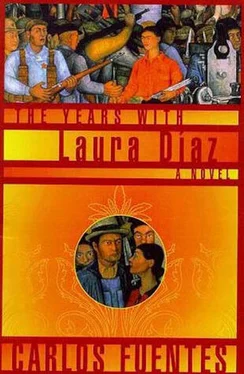
 an molotes , fried turnovers filled with beans and minced meat. They made their own bread: the French military occupation a half century before had imposed the baguette as the bread of fashion, though in Mexico, where diminutives are used as a sign of tenderness for both things and people, baguette became bolillo, and telera were pieces of bread about the size of a hand. Mexico’s traditional sweets were not abandoned — the sugar cookies and the cemita, covered with caraway seeds, as well as the wonderful sweet breads shaped like conch shells — and the tastiest gift of Spanish bakeries, churros , long strips of fried batter cakes covered with sugar and eaten after dipping them in hot chocolate.
an molotes , fried turnovers filled with beans and minced meat. They made their own bread: the French military occupation a half century before had imposed the baguette as the bread of fashion, though in Mexico, where diminutives are used as a sign of tenderness for both things and people, baguette became bolillo, and telera were pieces of bread about the size of a hand. Mexico’s traditional sweets were not abandoned — the sugar cookies and the cemita, covered with caraway seeds, as well as the wonderful sweet breads shaped like conch shells — and the tastiest gift of Spanish bakeries, churros , long strips of fried batter cakes covered with sugar and eaten after dipping them in hot chocolate. az, in Santiago’s name; or perhaps it was Santiago who would go on fulfilling, from death, a life that Laura would incarnate in his name. In any case she associated the promise of her brother with her own space, a high, isolated place where he would have written and she, mysteriously, would find her own vocation, in homage to her dead brother.
az, in Santiago’s name; or perhaps it was Santiago who would go on fulfilling, from death, a life that Laura would incarnate in his name. In any case she associated the promise of her brother with her own space, a high, isolated place where he would have written and she, mysteriously, would find her own vocation, in homage to her dead brother. árez defeated the Emperor Maximilian. They thought the future of freedom was here. Then, when Porfirio Díaz came to power, they were disillusioned. A lot of them went back to Barcelona, where there was probably more freedom there in the turnstile governments that Sagasta and Ca
árez defeated the Emperor Maximilian. They thought the future of freedom was here. Then, when Porfirio Díaz came to power, they were disillusioned. A lot of them went back to Barcelona, where there was probably more freedom there in the turnstile governments that Sagasta and Ca 
